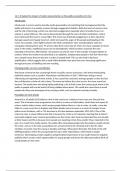AC 1.5 Explain the impact of media representation on the public perception of crime
Moral panic
Moral panic is a term used to describe media presentation of something that has happened that the
public will react to in a panicky manner through exaggerated statistics. Both the levels of serious crime
and the risk of becoming a victim are extremely exaggerated, especially when all media focus is on
violent or sexual offences. This can be demonstrated through the story of Mods and Rockers, where
teens destroyed the town in a mass fight. This event was drastically exaggerated, as facts about the
damage caused were hugely incorrect, which increased the anger of the people participating in the
event. For example, minor fights between the Mods and Rockers were sensationalised, with one
newspaper claiming there were 97 arrests when there were only 24. There are many examples of moral
panic in the media, amplifying issues such as islamophobia, which has been caused by the over-
reporting of terrorism. Alternatively, moral panic can also be seen in the example of moped attacks in
London, where the incident was described as an epidemic, leading many people to feel fear when they
see a moped incase they too become a victim of moped theft. This can also lead to deviancy
amplification, which suggests that a small initial deviation may spiral into ever-increasing significance
through processes of labelling and over-reacting.
Changing public concerns and attitudes
The threat of terrorism has caused high levels on public concern and worry, with these feeling being
fuelled by attacks such as London, Manchester and Barcelona in 2017. With there being so much
influencing and reporting of these events, it has caused fear and panic amongst people as they too fear
they will become a victim of such crimes. The more we believe the crime occurs, the more scared we
become. The media have also being highly publicising a rise in knife crime that causes great alarm in the
public as people will now be fearful of being stabbed when about. This could also cause them to avoid
people who they may stereotype to be carrying a knife, such as someone wearing a hoodie.
Perception of crime trends
Around 6 in 10 adults (61%) believe crime in the country as a whole to have risen over the past few
years. This is because news programmes are cited as a source of information, which does not report all
crimes, mainly violent crimes, which means people believe there is a rise in crime. In reality, crime has
fallen to a new record low in England and Wales despite some increase as a result of changes in how
police record incidents, with a 11% decrease in all crime between september 2013-2014. One of the
crimes to raise, is sexual offences but this is because the crime is not reported, meaning that it doesn’t
necessarily happen more. General perceptions are that crime rates have increased but they are actually
at their lowest and this is because more people are reporting crimes they wouldn’t have reported in the
past. As a result from media reports, the public often stereotype people who they believe would commit
the crime, such as in the USA, young black men are perceived to be criminals and in the UK, older
members of society view the young as hoodies and thugs. When given this label, this leads to the self-
fulfilling prophecy where the young people live up to their expectations, which leads to longer
sentences. Stereotyping creates negative and generalised impressions of our youths based on negative
publicity which creates unfair opportunities for young people and shows the older generations think all
young people are the same.





